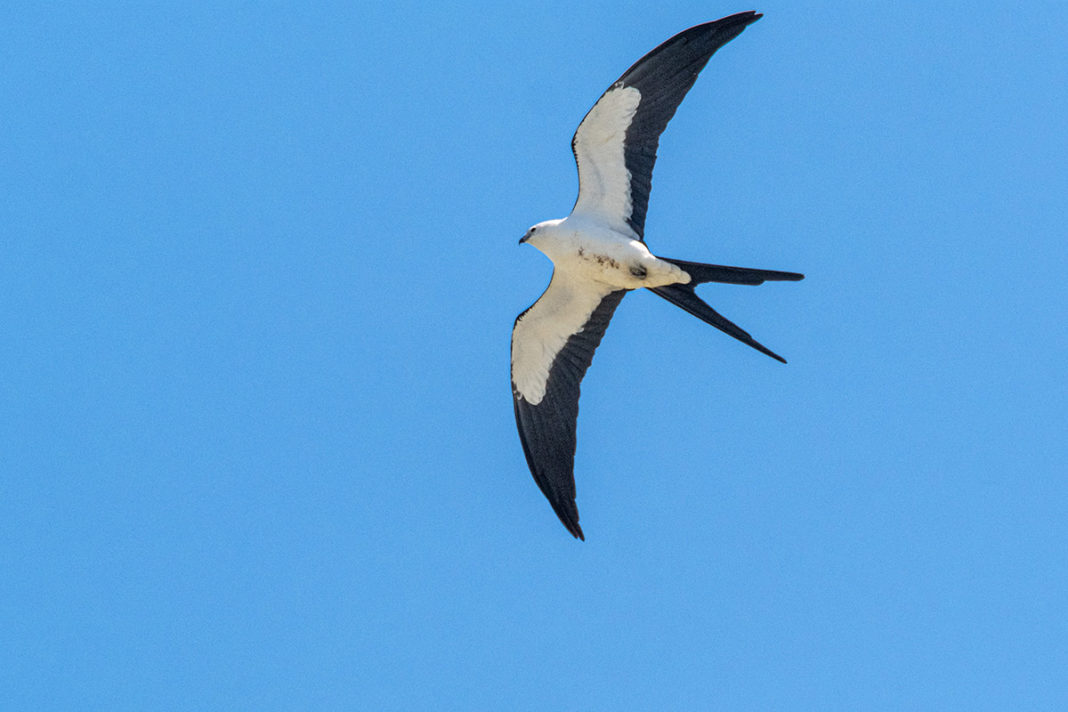The kite shot out from nowhere, just above the road, doing something of a bootlegger turn, its face angled one way, its body sliding another. Its wings were spread wide and kind of locked in place, but its long v-shaped tail was canted at about 45 degrees, working hard to stabilize the bird in the heavy wind.
The bootlegger turn was accompanied by the sound of screeching brakes, though they were mine, not the bird’s, as I locked the car up, swung the door open, and groped around for my camera without losing track of the bird. It was like something from a bad TV cop show, but it wasn’t exactly reckless, as I was way down at the end of Koehn Boulevard on Big Pine Key and there were no other cars or people in sight.
Someday I will lie flat on a therapist’s couch and get them to explain my mostly irrepressible urge to take a picture of every bird I see, no matter how many pictures I have of the species, but until then I’m just going to go on taking pictures and not worry about it.
Trying to line up the focus point on the bird, I had the usual regret – I should have played more video games as a child. If I had played more Space Invaders or Galaga or Duck Hunter or whatever, I would be far better at lining up small dots with moving things.
The bird circled around, into the sun and out, behind the tree, then out from behind it, because that’s what swallow-tailed kites do most often when you see them.
I did manage to get the camera to focus and captured a few frames. Nothing genius, but functional enough to show that it was, in fact, a swallow-tailed kite.
The bird did two loops, staying close for maybe 30 seconds, then tilted a wing and shot half a mile across the sky, almost as if it had been raptured.
I might have said “Welcome back” out loud as it went.
Swallow-tailed kites are just damn cool birds. There’s that long, v-shaped tail, the forward sweeping wings, the sharp black-and-white plumage, the old soul face. Plus, they give a dog-like yip sometimes when they fly. They spend their lives in the treetops and in the air, and don’t find much occasion to come down to the ground and slum with the likes of us flightless bipeds.
But they’re also some of the most casually bad-ass migrants around.
The American population of swallow-tailed kites lives mostly in Florida, but their range extends up to Georgia, South Carolina, Alabama, Mississippi and Louisiana. Their range used to extend as far north as Minnesota and Wisconsin, but habitat loss – they need tall trees in swamps to nest – has greatly curtailed that.
When they get ready to migrate south they gather in huge roosts of hundreds of birds, gorging themselves for a month on insects and the occasional unsuspecting lizard snagged from the treetops. Then they head for South America.
Most raptors, when they migrate, follow the same energy-efficient pattern, finding hot air thermals to ride up on, then gliding forward toward their destination until they find the next good thermal. This will get them across an entire continent without exhausting them. But when they need to cross a body of water, their methods change. Thermals weaken dramatically over water, and since they won’t survive landing in the ocean, they rely on powered flight, flapping to get where they’re going.
It’s the reason we get so many raptors migrating through the Keys every fall – the birds want to stay over land as long as possible and minimize the risk that comes with flying over water.
Swallow-tailed kites don’t really do the whole powered-flapping thing, at least not for any sustained period. They’re good at riding the wind and finding thermals other birds can’t. I always think of the rock climbers who can find the most subtle foot- and finger-holds on a sheer granite face. It’s a whole different level of reading the physical world.
As a result, swallow-tailed kites are less particular about their routes. If they fly over land, great.
If they fly over water, that’s fine, too.
Some years we see a lot of them in the Keys; some years, hardly any. We see many more of them in the fall than spring, making the bird I saw a near rarity, season-wise.
The folks at the lean, mean, ornithological studies machine that is the Avian Research and Conservation Institute in Gainesville have been using satellite trackers to follow migrating swallow-tailed kites for nearly 25 years. (Check out arcinst.org if you really want to go down the rabbit hole on swallow-tailed kite migration.)
While swallow-tails are incredibly good at making their way across the ocean, they do occasionally get caught by unfavorable winds and stuck out there. ARCI has never seen a bird fly for three or four days over the water before losing the signal, presumably because of mortality. At least not until last August, when a bird they’d dubbed Sanibel South made it to within 50 miles of the Mexican shoreline before getting blown off course. The bird stayed aloft for five-and-a-half days, traveling over 1,200 miles, before finally making it to Texas.
It would be impossible to say which route was taken by the bird I saw on Big Pine the other day. It may have crossed the 90 miles from Cuba. It may have made a 400-mile arc across the Gulf of Mexico. But it was in the last stretch of a 10,000-mile migration loop.
It didn’t look tired at all.


























